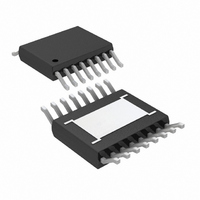LT3695EMSE#PBF Linear Technology, LT3695EMSE#PBF Datasheet - Page 13

LT3695EMSE#PBF
Manufacturer Part Number
LT3695EMSE#PBF
Description
IC SWIT REG BUCK 1A ADJ 16MSOP
Manufacturer
Linear Technology
Type
Step-Down (Buck)r
Datasheet
1.LT3695EMSEPBF.pdf
(30 pages)
Specifications of LT3695EMSE#PBF
Internal Switch(s)
Yes
Synchronous Rectifier
No
Number Of Outputs
1
Voltage - Output
0.8 ~ 20 V
Current - Output
1A
Frequency - Switching
250kHz ~ 2.2MHz
Voltage - Input
3.6 ~ 36 V
Operating Temperature
-40°C ~ 125°C
Mounting Type
Surface Mount
Package / Case
16-MSOP Exposed Pad
Lead Free Status / RoHS Status
Lead free / RoHS Compliant
Power - Output
-
Available stocks
Company
Part Number
Manufacturer
Quantity
Price
APPLICATIONS INFORMATION
A good choice of switching frequency should allow an
adequate input voltage range (see Input Voltage Range sec-
tion) and keep the inductor and capacitor values small.
Input Voltage Range
The minimum input voltage is determined by either the
LT3695 regulators’ minimum operating voltage of ~3.6V
(V
in Operating Frequency Trade-Offs section). The minimum
input voltage due to duty cycle is:
where V
is the minimum switch off time. Note that a higher switch-
ing frequency will increase the minimum input voltage.
If a lower dropout voltage is desired, a lower switching
frequency should be used.
The maximum input voltage for LT3695 regulator applica-
tions depends on switching frequency, the absolute maxi-
mum ratings of the V
mode. The LT3695 regulators can operate from continuous
input voltages up to 36V. Input voltage transients of up to
60V are also safely withstood. However, note that while
V
regulators will stop switching, allowing the output to fall
out of regulation.
For a given application where the switching frequency
and the output voltage are already fi xed, the maximum
input voltage that guarantees optimum output voltage
ripple for that application can be found by applying the
following expression:
where V
V
(~0.5V), V
f
the minimum switch on time (~150ns). Note that a higher
switching frequency will reduce the maximum operating
SW
IN
OUT
BD
V
V
> V
is the switching frequency (set by R
IN MIN
IN MAX
> 3V) or by their maximum duty cycle (see equation
is the output voltage, V
(
(
OVLO
IN(MIN)
IN(MAX)
SW
)
)
=
(overvoltage lockout, 38V typical), the LT3695
=
is the internal switch drop (~0.5V at max load),
1
f
−
is the minimum input voltage, and t
SW ON MIN
V
is the maximum operating input voltage,
V
OUT
f
SW OFF MIN
OUT
t
t
IN
+
(
+
V
and BOOST pins and the operating
V
D
(
D
)
−
)
V
−
D
D
V
+
is the catch diode drop
D
V
+
SW
V
SW
T
) and t
ON(MIN)
OFF(MIN)
is
input voltage. Conversely, a lower switching frequency
will be necessary to achieve optimum operation at high
input voltages.
Special attention must be paid when the output is in
start-up, short-circuit or other overload conditions. Dur-
ing these events, the inductor peak current might easily
reach and even exceed the maximum current limit of
the LT3695 regulators, especially in those cases where
the switch already operates at minimum on-time. The
circuitry monitoring the current through the catch diode
via the DA pin prevents the switch from turning on again
if the inductor valley current is above 1.6A nominal. In
these cases, the inductor peak current is therefore the
maximum current limit of the LT3695 regulators plus the
additional current overshoot during the turn off delay due
to minimum on time:
where I
the maximum expected input voltage, L is the inductor
value, t
output voltage under the overload condition. The parts are
robust enough to survive prolonged operation under these
conditions as long as the peak inductor current does not
exceed 3.5A. Inductor current saturation and excessive
junction temperature may further limit performance.
Input voltage transients of up to V
regardless of the switching frequency. In this case, the
LT3695 regulators may enter pulse-skipping operation
where some switching pulses are skipped to maintain
output regulation. In this mode the output voltage ripple
and inductor current ripple will be higher than in normal
operation.
Input voltage transients above V
be tolerated. However, since the parts will stop switching
during these transients, the output will fall out of regulation
and the output capacitor may eventually be completely
discharged. This case must be treated then as a start-up
condition as soon as V
and the part starts switching again.
I
L PEAK
(
ON(MIN)
L(PEAK)
)
=
2
A
is the minimum on time and V
is the peak inductor current, V
+
V
IN MAX
(
IN
returns to values below V
)
−
L
V
LT3695 Series
OUT OL
OVLO
(
OVLO
)
and up to 60V can
•
t
ON MIN
are acceptable
(
OUT(OL)
IN(MAX)
)
13
is the
OVLO
3695fa
is













